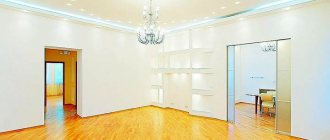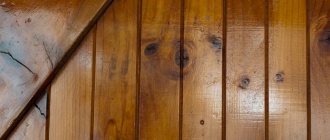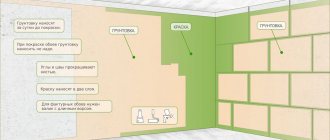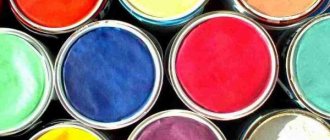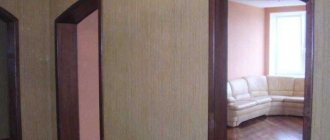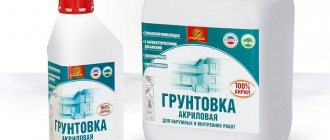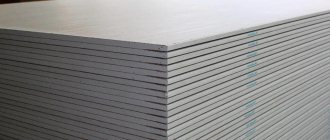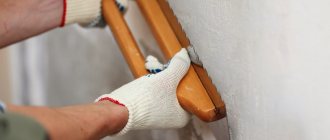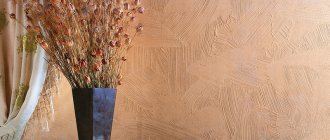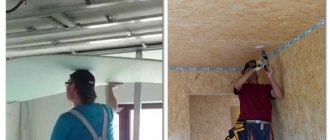What types of finishes are used for drywall
After creating the plasterboard structure, you can begin treating the surface with finishing materials.
It is important that during installation of the sheets all fire safety standards are observed. When finishing drywall, the following options are used:
- wallpapering;
- painting with waterproof and structural paint;
- finishing with mosaics and ceramic tiles;
- textured plaster;
- cork covering;
- flat stone finishing.
The top of the decorative plaster and painting can be coated with glossy or matte varnish.
As you can see, there are many finishing options, and all of them are acceptable for drywall, now it all depends on the design and preference of the owner. Before using these materials, you need to stock up on the necessary tools and knowledge.
Preparing the wall
You can’t do without preparatory work.
Before leveling the walls in the apartment, all old coverings should be removed from them to the base. This is especially true for plaster and shingles, which have already become dilapidated and easily come off the wall. Moreover, dismantling the old covering will help get rid of the extra centimeters that will be occupied by the covering.
It is not necessary to prime the wall, but it is advisable. It is important to treat it with antiseptic agents, especially if the external wall is being sheathed. On the floor near the wall and the ceiling, it is necessary to display with lines the boundary of the wall that will be built from plasterboard.
Is drywall putty necessary?
Although a sheet of drywall appears completely flat and smooth, in reality it is not so. To achieve a smooth surface, it is important to putty all joints, recesses and screws that were screwed to the frame during installation.
Putty also allows you to strengthen the adhesion of finishing materials, especially for wallpaper and tiles.
Putty can be omitted only in one case - if painting is carried out.
However, it is worth using a putty mixture to cover the seams and screw heads. And it is very important to prime the surface with a special solution. But if the paint is too light and the drywall will show through, then to save paint, you can apply putty in one thin layer.
For wallpapering, puttying is required. It is enough to apply the solution in a uniform small layer over the entire surface to completely level it. The thickness of the layer is no more than 0.5 millimeters. This will allow you to avoid damaging the drywall sheets when changing the wallpaper.
The gypsum board is based on paper, so wallpaper without putty will stick tightly, and it will be simply impossible to tear it off.
Putty will never do any harm, so for safety it is better to apply a small layer of the mixture; you should not skimp on this.
Basic methods of installing drywall on a wall surface
To evaluate the advantage of frameless installation of drywall, you can briefly consider both existing methods by comparing them.
To be fair, it should be noted that sometimes when installing drywall it is impossible to do without installing a frame, so this case is also worth mentioning when considering methods for installing the material.
So, there are two main technologies for attaching plasterboard sheets to the wall in order to level it:
Schematic diagrams of the two main technologies for leveling walls with plasterboard
- Installation of sheets using self-tapping screws on a frame made of a metal profile or wooden beam. This method is chosen in cases where the wall requires additional thermal or sound insulation, and the insulating material is installed specifically in the frame structure, or if the wall has very large distortions that are difficult to level with plaster layers.
- Fixing sheets to the wall using self-tapping screws and polyurethane foam or using an adhesive composition made on a gypsum basis. Self-tapping screws and foam for fixing drywall are used if it is necessary to cover not only a wooden wall, but also surfaces made of other materials that require correction. The adhesive gypsum composition is more often used to level a concrete or brick wall. However, it should immediately be noted that the frameless method of attaching drywall should only be used when the walls have a height not exceeding 3000 mm.
This publication will consider the nuances of only frameless fastening of drywall.
Proper processing of joints and seams, walls and ceilings
To process seams and joints, you must proceed step by step, following the following recommendations:
- Initially, you need to make sure that the joining areas fit snugly to the frame. Each self-tapping screw must be screwed in with a screwdriver, at least one millimeter deep. In this case, the cardboard must not be damaged.
- Now the surface is cleared of debris and dirt. The further quality of finishing materials depends on this preparatory work. Primer solutions are used for cleaning.
- You can start sealing the seams. A small amount of the mixture is applied to the spatula and pressed as much as possible into the seams; the remaining putty must be spread along the joint so that there is no transition at all.
- To seal joints, it is effective to use a gypsum mixture, as it is easy to sand and dries quickly.
- Gypsum also has high tenacity (adhesion), which is especially good for ceiling joints.
Now you need to stick the serpyanka onto the putty, leveling it carefully with a spatula.
It is important that the serpyanka is completely drowned in fresh solution. After the putty has dried, you need to apply another thin layer of the mixture so that the tape is not visible. After the putty mixture has dried on the seams, you can begin processing the walls.
A special role should be given to the finishing of the corners. To do this as efficiently as possible, protective plastic or metal corners are used. When gluing them, you need to use a level, then the corners will be even, and in the future, when finishing, there will be no problems with joining.
Excess mixture must be carefully removed with a tool. Now the solution is applied in a thin layer to the entire wall.
After the material has dried, the surface is sanded with a mesh or a special grinding tool. The main thing is not to overdo it and not to take off too much.
The ceiling is puttied in the same way as the wall surface.
If the ceiling is being prepared for painting, then, unlike previous recommendations, additional bandaging is carried out.
To do this, take a glass non-woven bandage or bandage tape, which is glued with PVA to the entire ceiling surface (the tape should be moistened with water).
Before doing this, the glue should be diluted to make it easier to spread on the material.
When gluing, you should act carefully, then go and press with a spatula to get rid of excess glue and eliminate air bubbles.
Construction work requires precision and consistency, so if you are not confident in your abilities, it is better to seek help from a specialist.
Let's watch a video on how to properly putty drywall:
When is it better to use drywall instead of plaster?
Smooth, even walls are the basis of repairs. Drywall boards can produce quick and effective results (with proper assembly and careful joining of sheets). They not only level the surface, but also help hide various defects.
If the humidity in the room is high, then you can use sheets with water-repellent impregnation. The material can even be laid on a wooden base and rounded elements. GCR is also suitable for finishing various partitions, suspended ceilings, and covering small sections of walls.
For walls, gypsum board sheets with a thickness of at least 12.5 mm are used. Moisture-resistant material (with special impregnation) is often used for finishing commercial premises, less often in apartments.
Products can be attached to the wall immediately after priming. Plasterboard sheets are easily connected to each other (they are pre-cut to obtain the desired size, since standard plasterboards on the market are 120x200 or 120x300 cm). Before gluing the sheets, you should completely remove the old plaster from the base (this also applies to other coatings).
Installation of material on different bases
Installation of drywall is simple:
- The panels are attached directly to the surface using gypsum glue.
- The glue is applied at several points (it is not necessary to cover the entire surface of the plate).
- Press them against the walls, wait until the glue dries, after which the joints are puttied.
- The surface can be painted, covered with wallpaper or covered with decorative elements.
The glue is available in the form of a dry mixture. To prepare the solution, mix the powder with water (it is extremely important to follow the manufacturer's recommendations). The temperature in the room where the boards are glued should be within +10…+35°C. If the index is high, the glue may dry out too quickly, which will negatively affect the quality of the coating. The solution is applied using a spatula (both on the plasterboard itself and on the wall).
Drywall or plaster - which is better:
- As for ceilings, you can finish them with either plasterboard or plaster. If gypsum boards are used, they should be laid on special frames. Gluing panels to the ceiling, as is done for walls, can cause the sheets to peel off.
- For rounded surfaces, depending on the radius of the circle, different materials are used. Flexible plasterboard sheets are only suitable for slightly curved surfaces; they are not used if the base is strongly rounded.
- For more curved surfaces, you can use semicircular metal panels that will allow you to install drywall (on rounded corners of walls, arched openings, etc.).
What primer is suitable for saturating drywall before painting?
Primers are divided into the following types:
- adhesive;
- water repellent;
- non-flammable;
- antiseptics (antifungal);
- deeply penetrating.
For plasterboard sheets, an acrylic primer is often used, which has the following properties:
- non-toxic, harmless to humans;
- dries quickly;
- has good penetrating ability;
- promotes uniform coloring;
- does not deteriorate from chemicals;
- increases adhesion;
- protective film eliminates dust and reduces material consumption;
- resistant to moisture and high temperatures.
It is more effective to use a colorless solution for painting. The most popular is Ceresit 117 station wagon.
When purchasing a primer, you should familiarize yourself with its composition and scope of application; this information should be indicated on the packaging.
We will learn more about how to coat drywall before painting by watching the video:
Construction of the frame
To build the frame, a special galvanized profile is used. In this case, profiles of several types and shapes are used. First of all, UD profiles are mounted on the ceiling and floor, as well as on adjacent walls, with their central part resting on the surface.
They should be secured with dowels. In the resulting frame, you can begin installing vertical jumpers from the CD profile, which will serve as a support for the drywall sheets. At the same time, they are fixed with their edges to the wall, and with their flat, wide edge into the room. You can attach the profiles with special screws with a drill at the end; they are specially designed for galvanized profiles and easily make holes for themselves and twist the frame parts. The first profile is installed directly at one of the side walls.
All others are 600mm apart. The distance is measured from the center of one profile to the center of another, and not from their edges. This distance is justified by the standard gypsum board width of 1200 mm and is designed for fastening the sheet at the edges and in the center.
The profile is also tightly fastened under the other wall, even if the distance from it to the previous one is less than 600 mm.
For reliability, special perforated hangers are used. They are galvanized strips with stiffening ribs in the central part and perforated at the ends. They are bent in the shape of a “P” and mounted in the middle on the wall under each vertical profile.
The edges-ears are screwed to the profile. In this case, it is important to maintain the installation level of the profile. If the length of the sheet is 2500 mm less than the height of the walls, then it is necessary to add pieces of gypsum board from above or below. To do this, jumpers are mounted at a height of 2500 mm between vertical profiles from the same CD profile.
How to prepare drywall for wallpapering
Preparatory work is carried out in stages:
- Primary primer.
- Seal all joints, cracks and screw holes with putty mortar.
- Gluing the serpyanka.
- It is important that the screws are completely recessed and do not stick out, otherwise it will damage the wallpaper or spoil the appearance.
- Now you need to putty the entire surface with gypsum mixture.
- After drying, the wall is plastered with a finishing solution.
The next stage is sanding. To finally get rid of dust, the sanded wall is primed again.
Next, you can start gluing wallpaper. If, after puttying, defects were found or the wall was damaged, then work must be done for this area again in the same sequence: priming, puttying, sanding.
At the very end, before applying wallpaper, you can lubricate the walls with wallpaper glue, this will strengthen adhesion and avoid future unraveling of the joints.
By following this sequence, there will be no problems with the wallpaper, and there will also be no difficulties if you want to change the wallpaper.
Do-it-yourself plasterboard wall covering: how to mount the frame
First, let's look at the necessary material. As a rule, leveling walls with plasterboard is carried out using two types of profiles - ud and cd. One thing to remember is that the ud (guide) profiles are designed to define the surface plane, and the cd (bearing) profiles serve to strengthen the structure and give it volume.
Now let's talk about the frame. Based on the fact that ud profiles are designed to form a plane, we draw a simple conclusion - they must be installed on the floor, ceiling and walls adjacent to the surface being sheathed. The installation sequence is as follows:
1. First comes the floor - if we are talking about maintaining the geometry of the room and maintaining angles of 90˚, then special attention must be paid to the floor guide. To keep everything clear, it is necessary to install floor guides along all existing walls. If we are talking about only one wall, then the direction of this guide must be chosen based on so that as little space is stolen as possible.
2. Now the adjacent walls - you can’t do without a level here. The wall guide profile is inserted into the floor one, after which it is positioned relative to the vertical level and secured with dowels or self-tapping screws.
3. Well, last but not least, a ceiling guide is installed, which is inserted at one end into the left wall profile and at the other into the right one. In fact, the installation direction of this profile is already set by the wall guides, so during the mounting process it remains to slightly adjust its position using a long level or thread.
The next stage, which involves leveling the walls with plasterboard with your own hands, is strengthening the frame and giving it volume. One thing should be understood here - it is to these profiles that the drywall is screwed. Therefore, special attention needs to be paid to two points.
According to these requirements, we install CD profiles:
1. First of all, you need markings. Every 400 or 600mm from any wall we mark vertical lines running from the ceiling to the floor.
2. Further, relative to these lines, every 600 mm, starting from the floor, we install U-shaped brackets on the wall. They need to be placed with this gap along each of the drawn lines.
3. Now it’s up to the cd load-bearing profiles. We cut them to the required size and insert one end into the ceiling guide profile, and the other into the floor guide profile.
We position them according to the markings of 400 or 600 mm and attach them to the guides with metal screws with a diameter of 3.5 mm and a length of 9.5 mm. Popularly these screws are called “teks”, “fleas”, “bugs” or “elems”. They need to be installed in two pieces on each side of the cd profile.
4. The final stage of leveling walls using plasterboard, or rather constructing a frame, is attaching the profiles to the existing wall. To ensure that the cd profiles do not fall out of the plane, it is necessary to stretch a pair of threads across them, touching which the supporting profiles are fixed. They are attached to the U-shaped bracket on both sides with the same self-tapping screws with a diameter of 3.5 mm and a length of 9.5 mm.
Now we can say with complete confidence that the frame for the drywall is completed in full.
Sheathing with plasterboard and heat/sound insulation
After laying communications, the installation of plasterboard sheets begins. They are installed in the same way as for sheathing.
Do-it-yourself plasterboard wall covering begins on one side. Then, on the other side, insulation and/or sound insulation is installed between the profiles (bars) of the frame. After its installation, the gypsum board wall is sewn up on the other side.
The usual insulation for walls and partitions made of plasterboard is used:
Mineral wool. This is glass wool, slag wool or stone wool (preferably basalt).
The most environmentally friendly - without formaldehyde - basalt mats. They are easier to work with than glass wool - no skin or respiratory protection is needed, they are less susceptible to moisture than slag wool, they are easy to cut and hold up well, without additional fasteners due to their high density. Their disadvantage is their high price.
The cheapest of these insulation materials is slag wool, the average price is glass wool, and stone wool is the most expensive. Basalt mineral wool slabs are easy to install. Foam plastic. To obtain good sound and heat insulation characteristics, a layer of 5-7 cm (density from 35 kg/m3) is sufficient. It is cheap, easy to install, retains heat well and conducts sounds poorly.
The disadvantage is that rodents love it and when burned it releases toxic substances.
Expanded polystyrene. One of the types of polystyrene foam. It is distinguished by a closed cell shape, due to which it has even better characteristics: it is denser, has excellent heat-insulating properties and dampens sounds well, rodents do not like it, and fungi do not develop on it.
It can be cut with a hacksaw and can be installed by surprise. Does not support combustion. The downside is the high price.
In principle, it is possible to use other insulation materials, but the ones listed are the most popular.
Advantages and disadvantages
There are several advantages to using drywall:
- environmentally friendly and safe for health;
- suitable for decorating any premises;
- easy to install;
- perfectly masks defects of surfaces and communications;
- has good thermal and sound insulation;
- creates a comfortable microclimate;
- completely ready for application of finishing coatings;
- affordable price.
There are no synthetic additives or toxic substances in drywall; it can safely be considered environmentally friendly and safe. The material lends itself perfectly to processing and modification. Thanks to this, complex reliefs and structures can be easily created. Pipes, wiring, wall voids, and various communications are quickly and accurately masked using drywall. It has the properties of absorbing and releasing moisture, regulating optimal climate indicators in the room. The front surface of the material is almost completely ready for decorative cladding. The cost of finishing gypsum plasterboard will be cheaper than plastering, while the process itself will be much simpler and cleaner.
Disadvantages include fragility and instability to strong influences of water. If a water supply breaks in a room and flooding occurs, then with prolonged contact with water, even moisture-resistant drywall will swell, deform and deteriorate. Strong impacts damage plasterboard surfaces, and shelves and racks made from this material cannot withstand too heavy objects. But if drywall is damaged, it can be easily repaired. And if you do not allow long-term interaction with large volumes of water, then we can assume that it has practically no disadvantages.
Required materials and tools
To successfully carry out facing work with plasterboard sheets, you will need to prepare a number of devices and materials.
To build the frame you will need:
- marker, knife for cutting drywall;
- measuring tape, building level, using a laser will reduce the time for marking;
- scissors for metal products;
- dowels;
- galvanized profile;
- perforated hangers;
- grinder, screwdriver;
- self-tapping screws for metal products;
- cutter (screws) to secure profiles together;
- plane, leveling the edges;
- spatula;
- a vessel where the solutions will be stirred.
For frameless you need:
- level;
- spatulas;
- rule;
- jigsaw or knife;
- grater;
- square, marker;
- rubberized mallet;
- screwdriver;
- putty;
- brush and roller for priming the surface;
- sealing tape;
- self-tapping screws
To successfully carry out facing work with plasterboard sheets, you will need to prepare a number of devices and materials.
The materials needed for installation are purchased based on the type of installation; the use of a frame structure will require:
- plasterboard sheets;
- when working with sheathing, the rack profile can be replaced with a guide;
- ceiling profile to strengthen the structure;
- the guide is designed to secure sheets to all possible surfaces;
- single-level connector, necessary to connect vertical and horizontal profiles;
- direct suspension, designed to secure the ceiling profile to the wall.
For the frameless method you will need:
- special glue, you can choose gypsum, or take other adhesives;
- primer solution;
- a mixture intended for sealing joint areas;
- if the work is carried out on a concrete or brick wall, then polyurethane foam will also be required.
The materials needed for installation are purchased based on the type of installation.
How to finish drywall - overview of options
Let's talk about what products are used today for finishing drywall.
Wallpaper on drywall - a decent finish
If we talk about what surface for applying wallpaper can be considered ideal, we can say with confidence - a plane lined with plasterboard. As we mentioned above, the walls covered with plasterboard sheets become perfectly smooth, that is, they do not need to be primed.
Wallpaper is often applied to gypsum boards
The wallpaper adheres perfectly to a uniform surface. All that remains to think about is to putty the joints that exist between the sheets of material.
Puttying drywall - the video will explain the entire procedure of work much better than any words, and we suggest you watch it.
As you have already seen while watching the video, puttying drywall is done using tile adhesive. Be sure to also putty the heads of the nails or screws on which the material was attached - otherwise, after some time, rust may appear: this will definitely not make you happy.
Before covering drywall with wallpaper, it is important to choose the optimal material for this. To produce a finish of this level, you can safely use all types of wallpaper that are sold today.
Before applying wallpaper to drywall, it is important to prepare the surface. The same can be said about coloring. Of course, the preparatory stage here is not very difficult, but you still can’t do without it.
- It is customary to glue the joints with serpyanka.
- It is important to fill the holes and seams from the screws with putty.
- When the putty dries, it is recommended to clean the surface: sandpaper is most often used for this.
- Now the drywall putty is done again.
- The surface is cleaned again.
How to attach and in what steps
When installing, the sheet is pressed against the frame and secured using a screwdriver and special self-tapping screws with flat heads. If the frame is made of metal, use TN25 screws (3.5x25 mm).
In stores they are called “for drywall.” Length - 25 mm, color - black (more often broken) or white. For a wooden frame, select those that are close in size with the flattest head: there will be less putty.
During installation, it is important to tighten the fasteners to the required depth: the cap should be recessed into the sheet, but the cardboard should not tear. It is also necessary that the self-tapping screw be installed strictly perpendicular to the plane of the sheet: this way there is less chance of damaging the cardboard layer, which in this design is responsible for rigidity.
When assembling the frame on a solid wall, the distance between the posts must be at least 60 cm. Then it turns out that each sheet is attached to three vertical profiles: two at the edges and one in the middle. In this case, the edge of the sheet falls in the middle of the profile.
Two sheets are joined exactly in the middle of the profile
Stepping back 10-12 mm from the edge, screw in the screws.
They can be placed, as in the figure above, one opposite the other, or they can be offset, as in the figure below. The installation step is 250-300 mm. Fastened along the perimeter and along the middle profile.
Where, how and with what steps to install self-tapping screws on drywall
Another important point: when cutting out sheets, keep in mind that its height should be 10-12 mm shorter than the height from floor to ceiling.
This is necessary in case of shrinkage: so that the wall or partition has the opportunity to compensate for changes in height without cracks (especially important for wooden and panel houses).
These are, perhaps, all the main points of working with drywall (without taking into account the specifics of installing profiles).

